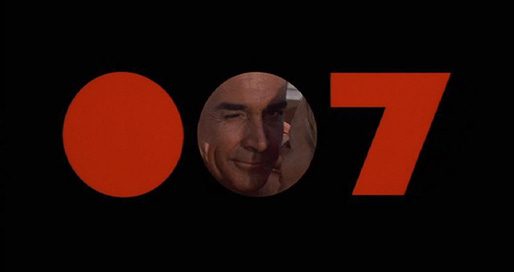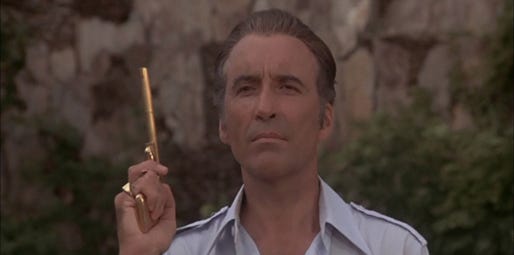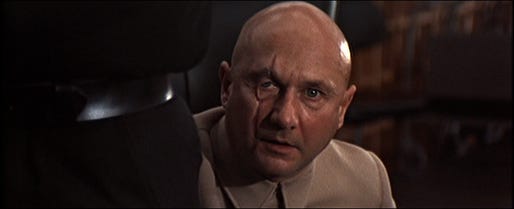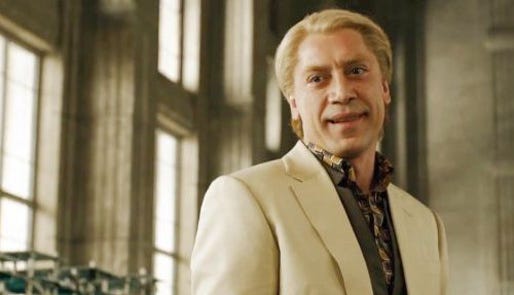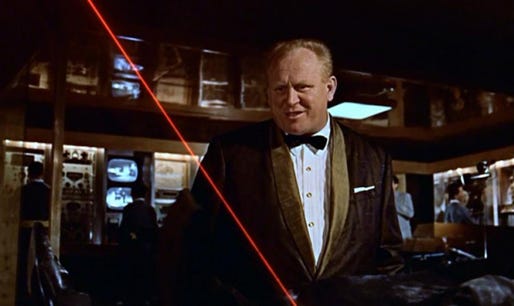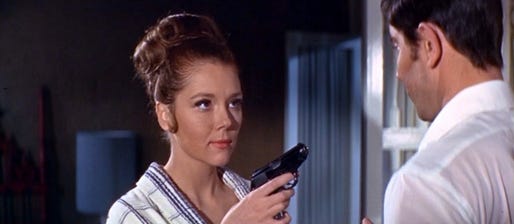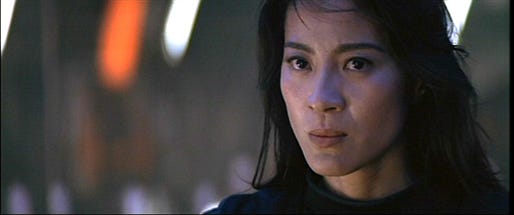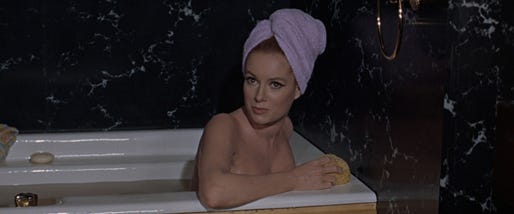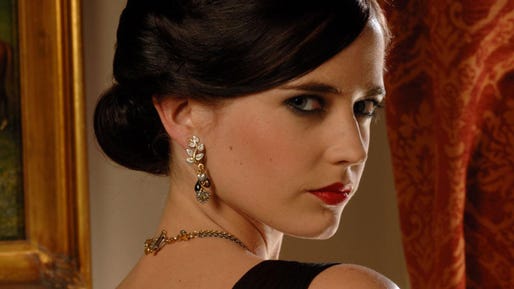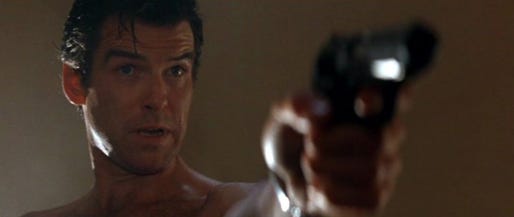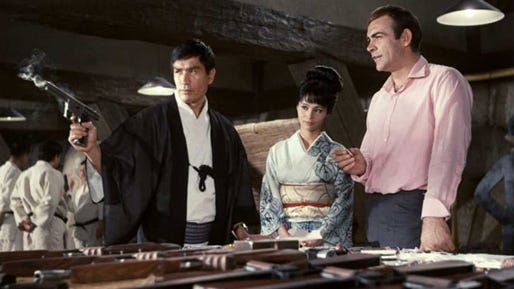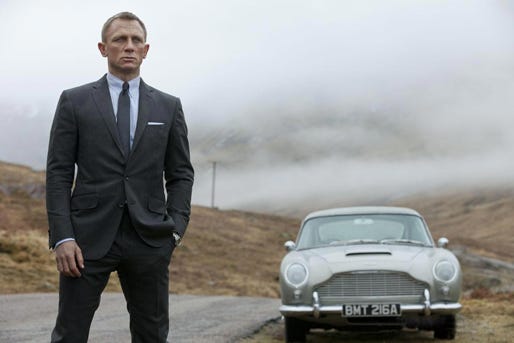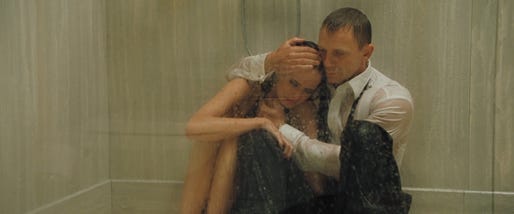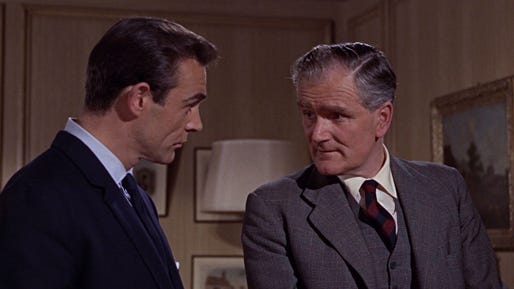You Only Live Twenty-Thrice: Unofficial Bonds and Official Rankings
“You Only Live Twenty-Thrice” is a look back at the James Bond films.
Each Friday until the release of the 23rd official Bond film, “Skyfall,” we will revisit its 22 official predecessors from start to finish, with a bonus post for the unofficial films in which James Bond also appears.
Technically, James Bond has been the lead character in 25 movies. But even he has cousins he’d rather not claim. The following movies are unofficial footnotes in official 007 history — ones that unfortunately emphasize the “ass” in “asterisk.”
CASINO ROYALE (1967)
Orson Welles. Hitler costumes. Garden-gnome security men. Woody Allen. Seals. Cowboys. Dancing Indians. Flying saucers. Exploding castles. Bubbles. Donkeys. Dogs. Levitating women. Seals. Horses. Deborah Kerr spouting Scottish gibberish.
A list of random things that could only coalesce in the deepest pockets of REM sleep? No. They’re all part of the nail bomb of nonsense detonated in “Casino Royale,” a 1967 spoof of James Bond “suggested” by Ian Fleming’s first James Bond novel.
Crazed proponents of this dreadfully indulgent cabaret, which thumbs its nose at coherence, have branded its nigh-impenetrable plot the sincerest form of satire. That’s like citing the indecipherable nature of Zapf Dingbats as the foremost send-up of language. This psychedelic swirl of annoyance keeps going and going and going.
In 1954, CBS paid Ian Fleming $1,000 to adapt “Royale” as an episode of its anthological “Climax!” series. The first actor to play James Bond, or Jimmy Bond, as he was called? Barry Nelson (gasp!), an American, and Peter Lorre played the villainous foil Le Chiffre. Then, a year later, Fleming sold the film rights to producer Gregory Ratoff for $6,000 … so he could buy a Ford Thunderbird. (Fleming was on record as regretting this decision.)
Ratoff was unable to mount a film before his death in 1960, and Charles K. Feldman — the agent-turned-producer of “A Streetcar Named Desire” and “The Seven-Year Itch” — acquired the rights. After “Dr. No’s” debut two years later, Feldman tried to work with Eon Productions’ Harry Saltzman and Albert R. “Cubby” Broccoli to put Connery in “Casino Royale.” But when that fell through, Feldman decided to send up the character instead in an all-star satire.
“Royale” became 1967’s eighth highest-grossing film — vastly outdone by Eon’s official 007, “You Only Live Twice,” but trumping Best Picture nominees “Doctor Dolittle” and “In the Heat of the Night.” But it’s an atrocity — the cobbled-together work of six directors (including the venerable John Huston, who also cameos) and what existed of Peter Sellers’ footage before he either quit the movie or was fired. (It’s said “Catch-22” author Joseph Heller, “Dr. Strangelove” screenwriter Terry Southern and the legendary Billy Wilder also had a hand in the hodgepodge script.)
The closest connection to Fleming’s source material finds Sellers as James Bond (nee Evelyn Tremble) at a baccarat table playing Le Chiffre (Welles) with help from Ursula Andress — Honey Ryder of “Dr. No” — as Vesper Lynd … and James Bond. (An explanation of that exponential weirdness in a bit.)
Two problems: Sellers seemed determined to make a legitimate spy drama, not a comedy — creating discordantly serious baccarat-table moments with Welles. Plus, Sellers and Welles loathed each other to the point that they were rarely on set at the same time. The exit of both actors from the movie is so bizarrely abrupt that it has to be a slap in the face to their unwavering prima donna attitudes. Sellers is gunned down in a hallucinatory scene of Scottish bagpipers (including Peter O’Toole as himself) and Welles is shot by a man … bursting through his surveillance monitor?
To compensate, a poor, unfortunate soul named Val Wells was tasked to salvage what he could and lean on David Niven footage to frame the story. Once suggested to play the official Bond for Eon, Niven here is Sir James, who long ago retired and has had “a sexual acrobat who leaves a trail of dead beautiful women” take his place.
Pressed into service after M (Huston) blows up his country manse, Sir James decides to flood the market with fake James Bonds to confuse the evil SMERSH. This includes Evelyn and Vesper, as well as Sir James’s nephew, Jimmy (Allen) and his daughter, Mata Bond (Joanna Pettet), sired from a tryst with Mata Hari.
Unsurprisingly, a $6 million budget doubled to $12 million — a figure no official Bond film surpassed until “The Spy Who Loved Me.” For all that money, there’s only the occasional explosion to function as an alarm clock and this brief, nifty car chase.
Wells should have simply junked the Sellers-Welles-Andress stuff — bankable as their names or affiliations might have been — and reshot the baccarat scenes with Niven. If nothing else, “Royale” would have been at least 45 minutes shorter. And there wouldn’t have been such a protracted wait for Allen’s inspired physical comedy in the final act — when he’s revealed to be the villain.
These fleeting moments of wit aren’t enough, though, to sit through what is otherwise a butt-numbing 131-minute endurance test — and a perfect example of Hollywood indulgence gone wrong.
NEVER SAY NEVER AGAIN
Can 1983 just be written off as a lost year for James Bond?
First, the third-rate third-world misadventures of “Octopussy,” Roger Moore’s official 007 film. Then, Sean Connery making yet another dreary fat-paycheck return to the part for “Never Say Never Again” (its title referencing Connery’s 1971 quip that he would “never again” play 007 after “Diamonds Are Forever”).
It’s a remake of “Thunderball” — the lone official Bond not produced by a Saltzman or Broccoli. After a legal battle in which he asserted co-authorship of “Thunderball,” producer Kevin McClory got official credit for that film and its rights in perpetuity. He was enjoined to refrain from making another version for 10 years. And although it would be 18 before it finally happened, his timing seemed fortunate.
By the early ’80s, McClory banked on Moore’s departure from the official role (after Moore’s contract was up) and a poor choice from Broccoli to fill his shoes. Throwing $3 million and profit percentages at Connery, then 52, got “Never” going, and Broccoli, fearing a new actor couldn’t compete, persuaded Moore to stick around.
So, dueling 007s, both of which earned big box office. This one essentially updates one of the canon’s weaker films with video games and Jazzercise.
And although Connery is notably fitter and trimmer here than he was a dozen years earlier, he doesn’t even attempt an accent other than his own. But, hey, money talks in any dialect, right?
Eon Productions held trademarks on many things, but surely an isolated opening-credits sequence wasn’t one of them. Instead, a drippy, insipid title song from singer Lani Hall plays over a title skirmish that turns out to be a training exercise. Barred from using the “James Bond Theme,” composer Michel Legrand’s score embarrassingly struggles to find a musical touchstone. Much of it sounds like generic smooth-jazz you’d hear while trapped at a crummy hotel bar.
Instead, it would have been nice to first see Bond teaching — as we learn has become his lot at MI6 instead of fieldwork. As it is, we’re not sure just why he’s been given a shot to again prove himself in training, but he’s told he has too many “free radicals” in his body. And that’s what sends him to a spa clinic where, as in “Thunderball,” 007 catches wind of SPECTRE’s plot to steal U.S. nukes.
After hardy-har-har jokes about colonics and urinary trajectory, there’s one inspired fight — in which Connery, clad in sweatpants and sweatshirt, takes on a Jaws-like behemoth of his own and uses free weights as brass knuckles to no avail.
Once Bond tracks the nukes to the Bahamas, he beds Fatima Blush (Barbara Carrera), “Never’s” weak-tea replacement for hot-toddy Fiona Volpe. Fatima is the main lackey to Largo (Klaus Maria Brandauer), a SPECTRE golden boy doing the bidding of Blofeld (Max von Sydow, wasted in an extended cameo). Her duties include seducing Bond, and this causes Connery and Carrera to share the most simultaneously silly and erotically charged sex scene of any Bond movie up to that point. (That’s Carrera doing her own thrusting .)
Oddly, Fatima becomes so concerned with being Bond’s No. 1 conquest, she threatens him at gunpoint, making him promise his memoirs will name her as such before he gets the drop on her.
During this scene, did director Irvin Kershner wonder how, and why, he went from “The Empire Strikes Back” to something along the lines of a bad TV movie? “Never” has only the thinnest sheen of professionalism, and it’s hard to watch “action” moments like this without snorting.
At least stunt rider Mike Runyard executes sweet leaps during a motorcycle chase. We get a black Felix Leiter (in Bernie Casey) 23 years before the official franchise got around to it. And once you get past the Jazzercise, Kim Basinger makes for a so-so Domino. Honestly, Brandauer is the best thing about “Never” — a more appropriately aged and, despite the scarves, menacing Largo than Adolfo Celi.
Five years later, Connery would have his Oscar. The following year, he’d assume another iconic role as Indiana Jones’s father. But in 1983, all he did was contribute to a depressing dilution of the 007 brand — one that ended with a fourth wall-breaking wink indicative not of arch fun, but of bored indifference.
THE FINAL DEBRIEFING
So, who and what are the best and worst of the official Bond films? A look at 007’s lovers, foes, musical numbers and the films themselves, in reverse order of worst to first, including "Skyfall" — a film that suggests Commander Bond has at least another decade, or more, of fight left in him.
The Villains These rankings pertain to those considered the main villain in each Bond film.
23. Kamal Khan (Louis Jourdan), “Octopussy”: Checking in at 60-plus, Khan feels like he’d be the villain in an well-armed version of “The Best Exotic Marigold Hotel.”
22. Ernst Stavro Blofeld (Charles Gray), “Diamonds Are Forever”: The third Blofeld is the worst, more forgettable than formidable and donning drag to escape.
21. Hugo Drax (Michael Lonsdale), “Moonraker”: Top-notch dry humor, but this Hitler wannabe is laughably ineffective at staging “accidental” deaths for 007.
20. Elektra King (Sophie Marceau), “The World is Not Enough”: Marceau lacks enigmatic affectations to play up suspense or a sadistic edge once she’s revealed.
19. Emilio Largo (Adolfo Celi), “Thunderball”: His eyepatch is unexplained and unthreatening, and his Spencer Tracy thickness is easily overcome in a final fight.
18. Brad Whitaker (Joe Don Baker), “The Living Daylights”: This merc literally models himself after Genghis Khan, but his shooting-gallery clash with 007 falls flat.
17. Dominic Greene (Mathieu Amalric), “Quantum of Solace”: An oily fella with fascist-dictator bangs and a quasi-hunch, he squeals like a girl. No match for Bond.
16. Aristotle Kristatos (Julian Glover), “For Your Eyes Only”: A boilerplate villain, but one with a mean streak as he drags 007 and Melina across coral reef.
15. Kananga / Mr. Big (Yaphet Kotto), “Live and Let Die”: Bond-ifying his heroin plot would help him be more than just a sinister bad guy, but he has a great death.
14. Franz Sanchez (Robert Davi), “Licence to Kill”: In most Bonds, he’d be a sadistic second fiddle. Davi shines, but his megalomania is pointless and convoluted.
13. Elliott Carver (Jonathan Pryce), “Tomorrow Never Dies”: Pryce has a hoot here, giddy and breathless with a hitch in his throat and mockingly loosey-goosey.
12. Stromberg (Curt Jurgens), “The Spy Who Loved Me”: A real sixtysomething sociopath who, like Auric Goldfinger, is ruthless, methodical and patient in his plans.
11. Ernst Stavro Blofeld (Telly Savalas), “On Her Majesty’s Secret Service”: Set aside ridiculous monologues (“I’ve taught you to love chickens, love their flesh”) and savor the active pursuit as Blofeld tosses his cat aside to partake in some brutality.
10. Rosa Klebb (Lotte Lenya), “From Russia with Love”: As 007 and Tatiana have sex, she’s the one smoking. Plus, her final knife-toed swipe at Bond is unforgettable.
9. Gustav Graves (Toby Stephens), “Die Another Day”: A beefy, blocky slab who’s like Hugh Grant’s homicidal twin — dandy but deadly and powered by uncut rage.
8. Le Chiffre (Mads Mikkelsen), “Casino Royale” (2006): A master manipulator of stock and secret agents, Le Chiffre legendarily lashes out at 007’s body and soul.
7. Dr. No (Joseph Wiseman), “Dr. No”: With metal hands and mixed-race heritage, he has somber, geopolitical motivation: Wanted by no one, he’ll target everyone.
6. Max Zorin (Christopher Walken), “A View to a Kill”: Memorably upsetting within PG confines, Walken empties Uzis into underlings and upstages Roger Moore.
5. Francisco Scaramanga (Christopher Lee), “The Man with the Golden Gun”: In an otherwise so-so outing, Lee’s malevolence lingers long in the mind. His weapon bears the hallmark of demented homemade craftsmanship. Plus, he has a flying car.
4. Ernst Stavro Blofeld (Donald Pleasance), “You Only Live Twice”: In five minutes, it’s the character’s definitive portrayal. When he twirls around to reveal his disfiguring scar, we know he survived that, so he can endure, and dispense pain.
3. Raoul Silva / Tiago Rodriguez (Javier Bardem), “Skyfall”: Silva often looks ready to begin the beguine. But his is a devil's dance with frighteningly choreographed invasions of physical space, psychotic long cons and chaos-agent violence.
2. Auric Goldfinger (Gert Frobe), “Goldfinger”: He who first seems a small-potatoes schmuck becomes a psycho with an inferiority complex and rage issues.
1. Alec Trevelyan / Janus (Sean Bean), “GoldenEye”: Forever in 007’s head with a meaty, sobering monologue, this psychological foe stalks him well past this movie.
The Lovers These rankings pertain to main Bond girls given substantial roles:
34. Dr. Christmas Jones (Denise Richards), “The World is Not Enough”: Richards can do light and frothy. Here, she’s the world’s loudest, bustiest physics tutor — so robotic you look for which extra is operating her remote control.
33. Mary Goodnight (Britt Ekland), “The Man with the Golden Gun”: This inane agent is trained in the arts of cowering, pouting, waxing and screwing up everything.
32. Corinne Dufour (Corinne Cléry), “Moonraker”: Say what you will about 007’s objectification, but “illiterate nympho” truly drops the misogyny to murky depths.
31. Tiffany Case (Jill St. John), “Diamonds Are Forever”: A dismally ditzy diamond smuggler who stiffly recites every line of dialogue as if from a cue card.
30. Lupa Lamora (Talisa Soto), “Licence to Kill”: Unconvincing and whiny (“I love James … so much!”), Soto fills the two-Bond-girl quota in a film disinterested in that.
29. Stacey Sutton (Tanya Roberts), “A View to a Kill”: Sleepy-eyed, throaty-voiced, this whimpering feeb doesn’t stand a chance next to Grace Jones’s May Day.
28. Paris Carver (Teri Hatcher), “Tomorrow Never Dies”: A tragic figure in no actress’s hands. But Hatcher never even tries summoning potential fear and conflict.
27. Octopussy (Maud Adams), “Octopussy”: Roger Moore yanks Adams’ lips to his with vigor, but there’s no spark and another self-confident woman turns to Jell-O.
26. Holly Goodhead (Lois Chiles), “Moonraker”: Chiles turns in a somnambulant performance, acting as if she heard “Action!” two seconds later than anyone else.
25. Dominique “Domino” Derval (Claudine Auger), “Thunderball”: A one-dimensional drip who makes a painful attempt at silent curiosity in the film’s finale.
24. Elektra King (Sophie Marceau), “The World is Not Enough”: The first Bond girl as the main villain could have been psychologically fascinating. Instead, Marceau is wispy and insubstantial both as a lover and a foe.
23. “Strawberry” Fields (Gemma Arterton), “Quantum of Solace”: Fields makes less of an impact as a doomed lover than a way to strengthen 007’s bond with M.
22. Solitaire (Jane Seymour), “Live and Let Die”: By giving supernatural powers to 007’s penis, the film robs Seymour of chances to be more than a very pretty face.
21. Pam Bouvier (Carey Lowell), “Licence to Kill”: Workable like much of the movie, but a specter of Teresa, with her short hair, sharp tongue and quick thinking.
20. Andrea Anders (Maud Adams), “The Man with the Golden Gun”: Had 007 simply targeted Scaramanga to avenge her death, the movie might have been better.
19. Sévérine (Bérénice Lim Marlohe), "Skyfall": Stunning in a skintight gown, she symbolizes "Skyfall's" idea of how protection can curdle into control. But in keeping with the Daniel Craig-era ethos toward most women, she's almost an afterthought.
18. Camille Montes (Olga Kurylenko), “Quantum of Solace”: The only lead Bond girl he never beds. Kurylenko nails her accent and the internalized rage of revenge.
17. Eve (Naomie Harris), "Skyfall": Eve is ostensibly a forceful, flirtatious ally. But her motivations remain mysterious, especially during a sexy/dangerous shave scene with 007.
16. Natalya Simonova (Izabella Scorupko), “GoldenEye”: Her smile and sass are strong but show the series’ inability to fully tackle 007’s psychological complexity.
15. Kara Milovy (Olivia D’Abo), “The Living Daylights”: A lithe ingénue for whom we buy that Bond would fall head over heels and a fast-acting companion in battle.
14. Pussy Galore (Honor Blackman), “Goldfinger”: A classically named, fetching forebear Kathleen Turner, husky voice and all. But Pussy is unnecessarily spayed.
13. Miranda Frost (Rosamund Pike), “Die Another Day”: Initially icy and bookish, her betrayal stings with shock. Even her attire is indicative of her hubris.
12. Kissy Suzuki (Mie Hama), “You Only Live Twice”: Façade or not, her marriage to 007 is contemplatively filmed and honorably tempers the series’ usual misogyny.
11. Tatiana Romanova (Daniela Bianchi), “From Russia with Love”: Beautiful enough to get men and women twisted up, Tatiana exudes a Hitchcock Blonde glow.
10. Melina Havelock (Carole Bouquet), “For Your Eyes Only”: Steely and set on revenge, Melina is like “Goldfinger’s” Jill Masterson, only far handier and heartier.
9. Giacinta “Jinx” Johnson (Halle Berry), “Die Another Day”: No acting chops. Just glib backtalk, good fights and, as Honey Ryder’s darker doppelganger, lust incarnate.
8. Honey Ryder (Ursula Andress), “Dr. No”: Only cursory chemistry with Connery. But, oh, the smelling salts required after her legendary saltwater-and-sex entrance.
7. May Day (Grace Jones), “A View to a Kill”: An iconic lover and foe in just a few minutes of screen time. For the first time in a bedroom, 007 looks a bit helpless.
6. Anya Amasova (Barbara Bach), “The Spy Who Loved Me”: Cast days before shooting, Bach conjured up the most fascinating chemistry Moore ever shared.
5. Teresa di Vicenzo (Diana Rigg), “On Her Majesty’s Secret Service”: Sexy like a schoolmarm and dangerous in a bipolar sort of way, Tracy is as resourceful as she is romantic. And her death is an emotional gut-punch unrivaled for almost 40 years.
4. Xenia Onatopp (Famke Janssen), “GoldenEye”: 007’s legacy of sex and violence in one eruptive package — her moment of orgasm and popping of bones aligned.
3. Wai Lin (Michelle Yeoh), “Tomorrow Never Dies”: The most bellicose good Bond girl ever — sexy, breathtakingly self-reliant and every bit 007’s heroic equal.
2. Fiona Volpe (Luciana Paluzzi), “Thunderball”: The first Bond girl worth a damn, flustering 007 with her take-charge sexuality, verbal taunts and violent acts.
1. Vesper Lynd (Eva Green), “Casino Royale” (2006): Redefining “Bond girl,” Green’s snippiness shifts into tenderness and suspense before an astoundingly tragic death.
The Songs These rankings include only main vocal themes from the official films.
23. “The Man with the Golden Gun,” Lulu: By a hair, the most badly bungled Bond theme, with truly lame lyrics and an annoying, two-syllable pronunciation of “gun.”
22. “Another Way to Die,” Jack White and Alicia Keys, from “Quantum of Solace”: Never once approximating the same key, White and Keys sound like cats in a sack, and White’s lyrics are equally tone-deaf — a Mad Libs parody of Bond.
21. “All-Time High,” Rita Coolidge, from “Octopussy”: With an embarrassingly ironic name, this adult contemporary glop has all the distinction of burnt, unbuttered toast.
20. “Tomorrow Never Dies,” Sheryl Crow: Crow isn’t suited to a smoky-nightclub vibe. You can hear uncertainty in her delivery and shredding in her vocal cords.
19. “From Russia with Love,” Matt Monro: Although the fromage of its cheese is significant, it gets just the slightest amount of slack as the first vocal Bond theme.
18. “Moonraker,” Shirley Bassey: Not the first bad Bond theme but the first bland one. Just try remembering even part of this lightweight tune’s melody in a few days.
17. “Thunderball,” Tom Jones: Jones sings the hell out of this from start to finish. The vibrato is right. But like the movie it accompanies, the vibe isn’t quite there.
16. "Under the Mango Tree," Diana Coupland, from "Dr. No": Before any true themes, Coupland put the right spin and sway on this lovely, lilting traditional Calypso tune.
15. “Licence to Kill,” Gladys Knight: Not the most chilling voice to sing of making people pay until their dying day. But Michael Kamen’s hefty orchestrations win out.
14. “GoldenEye,” Tina Turner: A sufficient, if not stirring, Bond theme that incorrectly suggests the film that follows will merely be going through the motions.
13. "We Have All the Time in the World," Louis Armstrong, from "On Her Majesty's Secret Service": Satchmo’s signature voice drives this sweetly, shuffling valentine to the sweet discovery of true love. But given tragic events, it becomes a cruel, ironic daydream.
12. “Skyfall,” Adele: J.A.C. Redford’s lavish orchestration and lyrics that are stirring in hindsight salvage unexpectedly snoozy vocals from Adele, who holds back throughout.
11. “The Living Daylights,” a-ha: The second-straight strong, edgy pop spin on Bond. It’s a persistent little earworom that sets the pulse of the movie it precedes.
10. “Die Another Day,” Madonna: Although its jittery sonic schisms are oft derided, it’s expertly integrated into the film with lyrics ripped from Bond’s psyche.
9. “For Your Eyes Only,” Sheena Easton: An aggressively sugary power ballad with a memorable, if not mighty, melody on which Sheena Easton vocally gives her all
8. “Diamonds Are Forever,” Shirley Bassey: For the first time, a touch of funk in the slippery drumbeat, which slinks around under Bassey’s hypnotic, brassy vocals.
7. “The World is Not Enough,” Garbage: Vastly superior to the film it accompanies, this irresistibly seductive torch song/sales pitch for domination swoops and soars.
6. “You Only Live Twice,” Nancy Sinatra: No Bond fanfare so immediately induces goosebumps like this swooner. Sinatra’s dispassionate vocals are an afterthought.
5. “Nobody Does it Better,” Carly Simon, from “The Spy Who Loved Me”: Though musically rooted in its era’s mellow adult-contemporary sound, boyishly boastful lyrics, Simon’s impeccable vocals and gradually building flourishes are legendary.
4. “A View to a Kill,” Duran Duran: As ’80s New Wave meets ’60s classicism, it hits like a shiv to the side with chillingly evocative lyrics and upper-register vocal frenzy.
3. “Live and Let Die,” Paul McCartney: No Bond theme shifts as many gears as deftly or dangerously as this aggressive rocker, which ends on a long, ominous note.
2. “You Know My Name”, Chris Cornell, from “Casino Royale” (2006): A swaggering orchestral-rock number that fuses Cornell’s ragged howl to a driving beat, crashing strings, intrusive brass and a chorus of haunting lyrics.
1. “Goldfinger,” Shirley Bassey: Oft imitated (even by Bassey) but unmatched, this instant-classic knockout built the template for Bond-theme mystery and grandiosity.
The Films
23. “Moonraker”: A giant leap backward for Bondkind, this slow-moving, clownish capper to an iffy decade generates no awe over sending 007 into the stratosphere.
22. “The World is Not Enough”: A sterile, sluggish adventure smothered by halfhearted attempts at suspense and the unforgivable wasting of a great henchman.
21. “Thunderball”: More interested in taking Bond to the bank than the brink, the blocky, overlong underwater action is drearily bad and the plot is lacking in payload.
20. “Diamonds Are Forever”: Less Sean Connery’s glorious return than a cheesy caricature, Connery shows none of the charm or confidence that made him great.
19. “Octopussy”: Uncharismatic villains, dead-eyed love interests, embarrassing disguises, lackluster action and a depressingly old 007 equal Moore’s second-worst.
18. “A View to a Kill”: Rather than creatively capitalizing on Moore’s aging, 007 enters blandly utilitarian territory while facing an unexpectedly strong villain.
17. “The Man with the Golden Gun”: Often, and unfairly, labeled “worst Bond,” it’s still a so-so romp, with a tremendous big bad, that could’ve been a bit more ragged.
16. “Quantum of Solace”: Often to the detriment of what makes Bond Bond, this go-go-go capper to “Casino Royale” (2006) slows only briefly but for the right reasons.
15. “Live and Let Die”: 007 walks a thin line in blaxploitation territory. But it was then a unique cultural juxtaposition and a fitting introduction to Moore’s Bond.
14. “Licence to Kill”: Timothy Dalton had little time to probe 007’s psyche. But, without quips, smirks or innuendoes, his raw, exposed nerves creates a big payoff.
13. “On Her Majesty’s Secret Service”: George Lazenby is inept. But the film is half terrible, half tremendous — neither unsung masterpiece nor unmitigated disaster.
12. “Tomorrow Never Dies”: It counters a skimpy plot with slick craftsmanship, heretofore unseen adrenaline and aggression, and a hellzapoppin tempo.
11. “For Your Eyes Only”: By lifting a veil Moore often draped over 007’s violent tendencies, “Eyes” goes grittier and restores vision, albeit not 20/20, to the series.
10. “Die Another Day”: Both a trippy rendering of 007’s staple ideas of duplicity and identity and an absurdly entertaining return to gadget-driven, gee-whiz what-ifs.
9. “Dr. No”: More mystery than adventure and comparatively low-key to its successors. But legends start somewhere, and “Bond before Bond” is fascinating.
8. “The Living Daylights”: Timothy Dalton’s dashing, dangerous debut as 007 showed an instinct to mix outward thrills and inner turmoil if not the full initiative.
7. “Goldfinger”: It killed off the careless, fallible Bond so the glib, gun-toting embodiment of cool could live. Sleek and swift, it’s stuffed with iconic moments.
6. “The Spy Who Loved Me”: Moore’s masterpiece. Bond goes big with a jaw-dropping opener, shrewd love interest and Jaws, his most frightening opponent yet.
5. “GoldenEye”: Boasting a superior villain and Bond girl, it treats 007’s livelihood as a zero-sum game fraught with impossible choices between friends and missions.
4. “You Only Live Twice”: Bond buries the needle on coolness, hitting a cruising altitude of kitschy spectacle with an imaginative plot and impeccable production.
3. "Skyfall": Pitched at the level of a psychological thriller and more stunningly photographed than any other Bond, the latest film looks toward the past and future with clear eyes — blending awesome action with sometimes uncomfortable intimacy you might find on a stage.
2. “Casino Royale” (2006): With raw emotions and action sequences, it’s as invigorating for its intimate revelations about 007 as for its hard-charging spectacle.
1. “From Russia with Love”: This cerebral thriller dares you to keep pace with its racing narrative of disloyalty and deception and establishes numerous 007 tenets.

